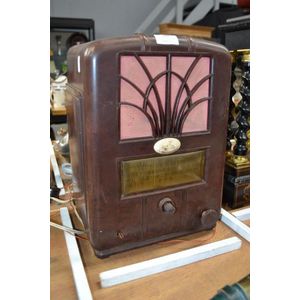Vintage Bakelite Radio by His Master's Voice
His Masters Voice Bakelite radio, approx 40 cm high, 28 cm wide, 22 cm deep
You must be a subscriber, and be logged in to view price and dealer details.
Subscribe Now to view actual auction price for this item
When you subscribe, you have the option of setting the currency in which to display prices to $Au, $US, $NZ or Stg.
This item has been sold, and the description, image and price are for reference purposes only.
- Bakelite - Bakelite was the first completely synthetic man-made substance. Bakelite was invented in 1909 by an independent New York chemist Leo H. Baekeland. It was called the "material of a thousand uses" and used to make everything from car parts to jewellery.
Although nearly all plastic from this period is known as ?Bakelite', it is important to remember that this is an umbrella term that covers many different early plastics such as Lucite and cellulose acetate, and includes Bakelite.
We often think of the colour of Bakelite items as dark brown, but it was manufactured in various colours including yellow, butterscotch, red, green and brown.
Bakelite could also be transparent, or marbleised by mixing two colours. Plastics were cheap to produce and could be moulded or carved in a huge variety of ways.
Bakelite is most commonly associated with radio cases of the 1930s, telephones and kitchen utensils, but it was also used extensively in jewellery manufacture.
Early designs from the 1920s were plainer and simpler than later examples. Geometric and floral patterns typical of Art Deco styling were popular.
During its heyday in the 1930s, Bakelite jewellery was stocked by the most prestigious stores, such as Saks, Harrods and Macy?s, who dedicated a shop window display to it in 1935.
Coco Chanel featured Bakelite items in her accessories collection and the material was praised frequently in Vogue magazine.
Manufacture of some consumer Items were suspended in 1942 in order to concentrate manufacturing on the war effort.
Small items made of Bakelite are now valuable collectables. Andy Warhol was an avid collector, and when he died in 1987, his pieces sold for record prices at Sotheby's. - His Masters Voice - "His Master's Voice", abbreviated HMV is a trademark in the music business, the image coming from a painting of the same name by English artist Francis Barraud. The American rights to the picture were purchased about 1899 by the Victor Talking Machine Company founded by the inventor of the gramophone, Emile Berliner after the painting had been modified to show the dog named "Nipper" listening to one of Victor Talking Machine Company's gramophones.
Further capitalising on the logo, an additional trademark, "Little Nipper" was later registered and used for children's records and radios.
Ownership of the HMV trademark was transferred through a number of companies in the music business during the 20th century including RCA (Radio Corporation of America) and EMI.
Barraud, the artist died in 1924 and the painting is now in the public domain, although the trademark is still valid.
This item has been included into following indexes:
Visually similar items

Antique Brittany single door carved oak vitrine, approx. 146 cm high, 64 cm wide
Sold by
in
for
You can display prices in $Au, $US, $NZ or Stg.

Painted cupboard with grill doors, approx 137 cm high, 59 cm wide, 33 cm deep
Sold by
in
for
You can display prices in $Au, $US, $NZ or Stg.

A superb Victorian walnut ormolu mounted pier cabinet. 112 cm high,85 cm wide,45 cm deep.
Sold by
in
for
You can display prices in $Au, $US, $NZ or Stg.

Antique Georgian mahogany glazed door corner cabinet, approx 150 cm
Sold by
in
for
You can display prices in $Au, $US, $NZ or Stg.
